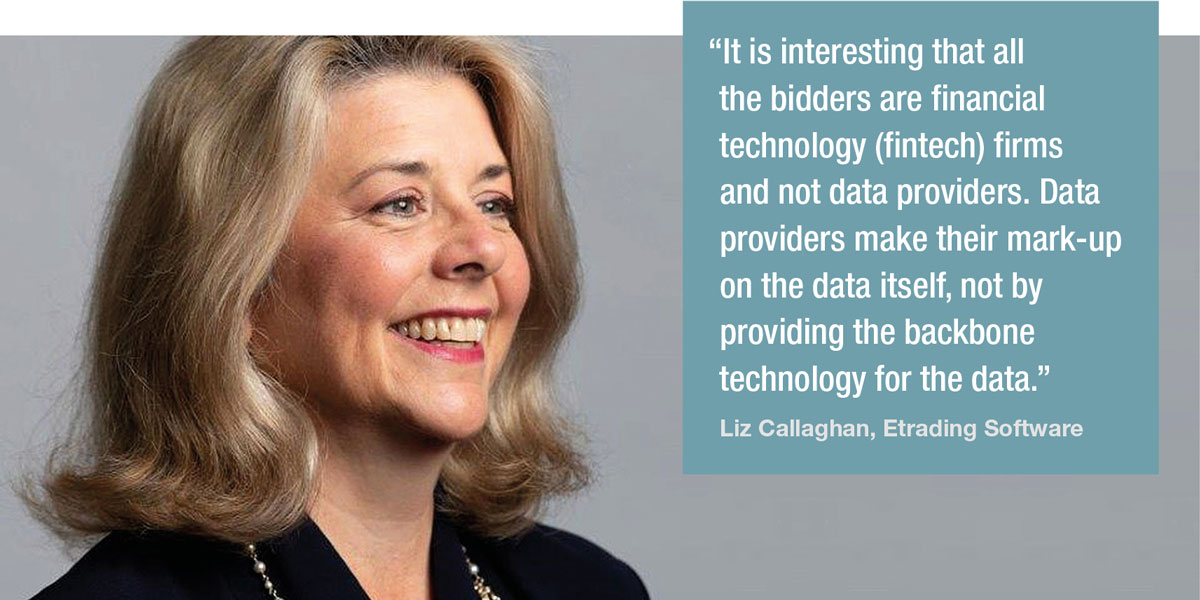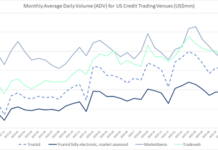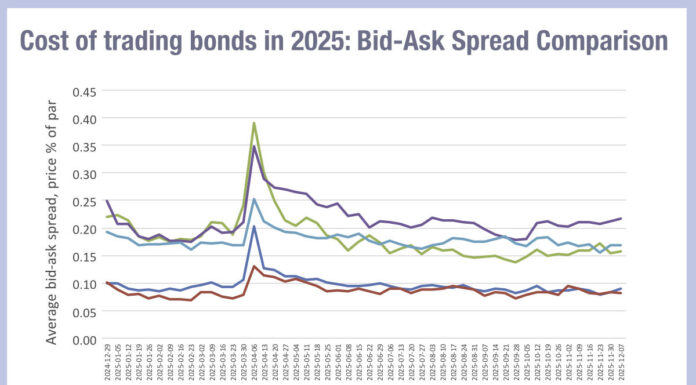Europe’s development of a consolidated tape for trading data now has clear front runners and benefits.
Three firms have confirmed they will compete to be consolidated tape providers (CTPs) for UK and European capital markets, with another three uncommitted and two erstwhile providers now ruling themselves out of the race.
Etrading Software plans to run tapes for UK bonds and for EU bonds and derivatives with total management control and data management, although it may select some tech suppliers for connectivity. Finbourne is planning to run a single tape for UK and EU markets with appropriate rules to match each jurisdiction and asset class, as part of a consortium, although it cannot yet name its partners. TransFICC is looking to join a consortium while providing the technology for the CT alongside partner firms that can manage compliance and governance. MarketAxess and Ediphy have both declined to comment on their plans, and Propellant Digital is currently watching from the sidelines.

“We spoke to some of the others that are thinking about engaging, so we are very open,” says Vincent Grandjean, CEO, Propellant Digital. “What we have achieved over the last three years, using our technology, is a much better understanding of the data. We believe we have a lot to bring, one way or the other. I’m not saying that we are not a runner, but the CTP process is a marathon, not a sprint.”
“Tradeweb does not intend to become a CTP,” said a spokesperson for the firm. “However, we still believe that the establishment of a robust fixed income consolidated tape, both in Europe and the UK, is critical to the ongoing advancement of these markets. We will, therefore, continue to engage and cooperate across multiple initiatives developing in this space.”
Bloomberg currently says it has no active plans to apply to provide a consolidated tape, but continues to monitor market developments.
“It is interesting that all the bidders are financial technology (fintech) firms and not data providers,” notes Liz Callaghan, chief strategy officer (CSO), market structure services, Etrading Software. “Data providers make their mark-up on the data itself, not by providing the backbone technology for the data.”

Those businesses who do engage will need to navigate one or both of the frameworks for development of consolidated tapes under each of the two regimes for the European Union and the United Kingdom, with regulatory oversight managed by the European Securities and Markets Authority (ESMA) and the Financial Conduct Authority (FCA) respectively.
“Internally we say there are six boxes, in theory; UK, EU, and for each bonds, equities, then derivatives,” says Neil Ryan, head of product marketing and solution messaging, FINBOURNE. “[For a CTP] it’s a question of how you colour in the six boxes. The Europeans have been pretty straightforward, with a website detailing what they’re doing. The timetable for the UK starts with bonds and they’re investigating equities.”
Four main challenges exist for tape providers. There are different approaches in each jurisdiction covering different asset classes, so a CTP will need to efficiently manage across these. Second are the operational aspects, including consortium negotiations. Third are technical elements, including the development of connectivity and interfaces. Fourth is the successful commercial management of the business once up and running.
Better versus different
Getting a consolidated tape for fixed income markets has been prioritised by regulators, as stock markets already have centralised price disclosure via stock exchanges. The difference a tape will make to bond markets is more fundamental, however. While it will be transformational, research by Zornitsa Todorova, analyst for thematic macro research at Barclays, indicates it will change liquidity rather than improving it across the board.
“Transparency decreases transaction costs for small trades and newly issued bonds, but it increases transaction costs for large trades and more aged instruments,” she wrote in a recent paper, entitled ‘The tale of the tape’. “These nuances are related to two important changes in the corporate bond market over the past 20 years: post-crisis regulations that raised capital charges for banks and increased the cost of inventory, and the introduction of exchange traded funds (ETFs).”

It is the effect on market makers, and their ability to offset the risk of positions taken on to support clients, that creates this disparity. “When inventory costs are high, posting trade details might put market makers in a more vulnerable position once they hold a bond in their inventory and search for the other side of the trade; ETFs provide real-time information about the price of corporate credit risk, potentially decreasing the benefits of transparency,” Todorova explains. “When it is difficult to quickly match buyers and sellers – as is the case for block trades – higher inventory costs might outweigh the benefits of transparency and result in lower liquidity.” Her analysis indicates it will be easier and cheaper to execute smaller trades on electronic platforms, and become harder to trade blocks, as these will become more reliant on voice traders’ knowledge and networks.
“The tape has the potential to accelerate systematic investing, generate more trading activity due to improved confidence in price markets, and attract new investors,” Todorova writes. Looking at the fixed income tapes across the EU and UK, the structures appear largely sound, according to potential bidders. “The EU has laid the groundwork with Level One text for a transformative corporate bond transparency framework that we think will facilitate, on an individual ISIN basis, price discovery and market overview,” says Etrading’s Callaghan. “There’s going to be a consultation shortly with the industry to create a more granular bond deferral framework.” She continues, “We’re very pleased to see that the FCA’s very rational transparency regime proposals include transparency deferral frameworks, that include both sovereign as well as corporate bond markets. The UK has the sovereign bonds in scope, whereas the EU really doesn’t. That is disappointing, but these things evolve over time.”

Tender or sore
Even as they engage in the bidding process, firms have concerns about the criteria used in the tender process in order to win the mandate of becoming a CTP.
“Very sensibly, the EU is picking up on price, data quality and governance, as value-based criteria,” observes Sassan Danesh, CEO, Etrading Software. “They’ll look at everything and then make an assessment. The UK’s first phase is a qualification process asking if you are fit and proper, have the financial capacity, governance model and data quality. The second phase is purely based on price.” This will mean candidates are forced into a race to the bottom for all the other categories, he asserts. “Effectively, candidates will ask the FCA, ‘What’s the lowest data quality that allows me to clear a phase one hurdle?’” Danesh notes. “There are no brownie points for clearing the hurdle by a margin. The industry is saying data quality is very important. Why are we aiming down?”
Callaghan notes the FCA is likely to see less than half a dozen candidates competing for the bid, so the need for a multi-stage evaluation process with price alone as the final determinant is questionable. “Firstly, a two-stage selection process for fewer than six candidates does not seem logical,” she says. “Secondly, what could the race to the bottom end up delivering? Either a CTP that can’t deliver during its five-year term on what the industry needs, or a CTP which has bid so low that it’s loss-making and goes bust halfway through the contract.”
Management headaches
Once a firm wins its bid for any one or more of the tapes, it will then need to deliver the product in a way that engages users and fits the framework. “On the fixed income side, the challenge is really to harmonise all of that data and present it in a meaningful way,” says FINBOURNE’s Ryan. “What the UK and the EU are looking for has not actually been achieved anywhere else. On the bond side, they’re looking for a big bang, all bonds, on day one. TRACE has been going for about 23 years in the US, and they don’t fully have government bonds. The assumption seems to be in Europe that if regulations have been passed it will get done, but there is a lot of road to travel still.”

“Operating a consolidated tape (CT) is a two-part challenge, technical and operational,” says Jason Waight, head of regulatory reporting at Bloomberg. “The technical challenge is not hugely problematic given the similarities to approved publication arrangements (APAs), which have been functioning for six years. Operational demands will be much more significant. This is the first such offering in Europe, demand is less than certain, and expectations from regulators are very high.”
However, Ryan notes that directly using MiFID II data has been challenging for firms.
“The complexity of accessing MiFID and MIFIR data in different file types and formats can leave people spending hours fiddling with Excel spreadsheets, where we can handle it in half a second,” says Ryan. “A number of large sell-side firms want one feed in, and where possible rationalise existing infrastructure and use what is already there. Making this as painless as possible is a big thing for large institutional businesses. If it is painful and pricey the answer from those businesses will be ‘no’, but if it is painless, the discussion moves on to price.”
Steve Toland, co-founder of TransFICC, also points out that the model for connecting to the trading venues is not consistent between the UK and EU.
“From a technology perspective the key difference is that in Europe they’re expecting the CTP to code to all the venues, where in the UK the CTP will provide an API spec, and everyone will code to that,” he says. Having the CTP do more work could well be better than relying on market operators, he observes, as this will allow it to set the timeframe for delivery. “On first look, the UK model looks simpler because the CT provider can put the spec together, but getting different people to integrate with a new spec is really hard,” Toland says. “Everyone drags their feet and says they haven’t got the resources ready. As a result it might take longer. In the European case, while it sounds like a nightmare, it’s better for us because we’ve coded to virtually every venue in Europe already connecting their post-trade feeds to all of our bank customers. It’ll be in a different format, but we can just repurpose and anonymise our post-trade feed.”

Making money
For longer term viability the commercial model will be paramount, and that will be dependent upon the value the rules give the data and flexibility on who is charged. Bloomberg’s Waight says, “The EU’s proposal permits the potential sharing of CT revenue with market data contributors, i.e., APAs and trading venues. The UK proposal only foresees the CTP providing compensation to the market data contributors in relation to connectivity costs.”
As Chris Murphy, CEO of Ediphy notes, there is potential for divergence in approach on deferrals around the data, and that will impact timeliness of the information the tape provides.
“There are five levels of deferrals set out for the bond tape by Europe,” he says. “The UK is thinking about a more streamlined approach. If the framework for deferrals and calibration of different periods is different, that could have knock-on consequences in terms of commerciality of the tape. Fewer deferrals increases useful data on the tape, in a real time sense. That could change commercial viability of the European tape versus the UK tape.”
Authorities have confirmed that CTPs will be able to provide differently costed services to users, based on the use of the data by that user, which has allayed concerns about the need for non-discriminatory pricing models. “Obviously, we will have different price points for re-distributors versus investment firms, but we want a simplified model that everyone can understand,” says Callaghan. “One that is objective, self-certification based. We’re finalising this now. We already have experience in a public-private partnership, because we are the managed service provider for the Derivatives Service Bureau (DSB). They report up to the regulatory oversight committee (ROC) for the Financial Stability Board (FSB), and ETS is the managed service provider for the DSB identifier service.”
Flexibility on who will engage still exists. Murphy cites a major barrier for engagement as continued uncertainty around the final parameters for delivery.
“There’s continued timing uncertainty, whether the tender process is going to slip – particularly in Europe – but also when you can get live as a production CTP. If they are looking to change the rules, at the same time as implementing the CTP, there’s going to be a period of time when the venues will need to do a lot of work to conform to the API that the CTP provides in the UK. The APIs and then the dealers will ask for time to implement these new deferral rules. It’s only then that the data can be provided to the CTP, to do the build-work necessary to then consolidate that data. The consequence is that the actual operational go-live of a CTP is probably further out than most people are thinking right now.”
As the process continues to evolve, the authorities in the UK and Europe will be taking account of these points, in order to deliver a successful project over two decades behind the US. Todorova writes, “Our results suggest that policymakers will need to strike a delicate balance between harnessing the benefits of transparency and preserving liquidity for large trades.”
©Markets Media Europe 2024
©Markets Media Europe 2025













